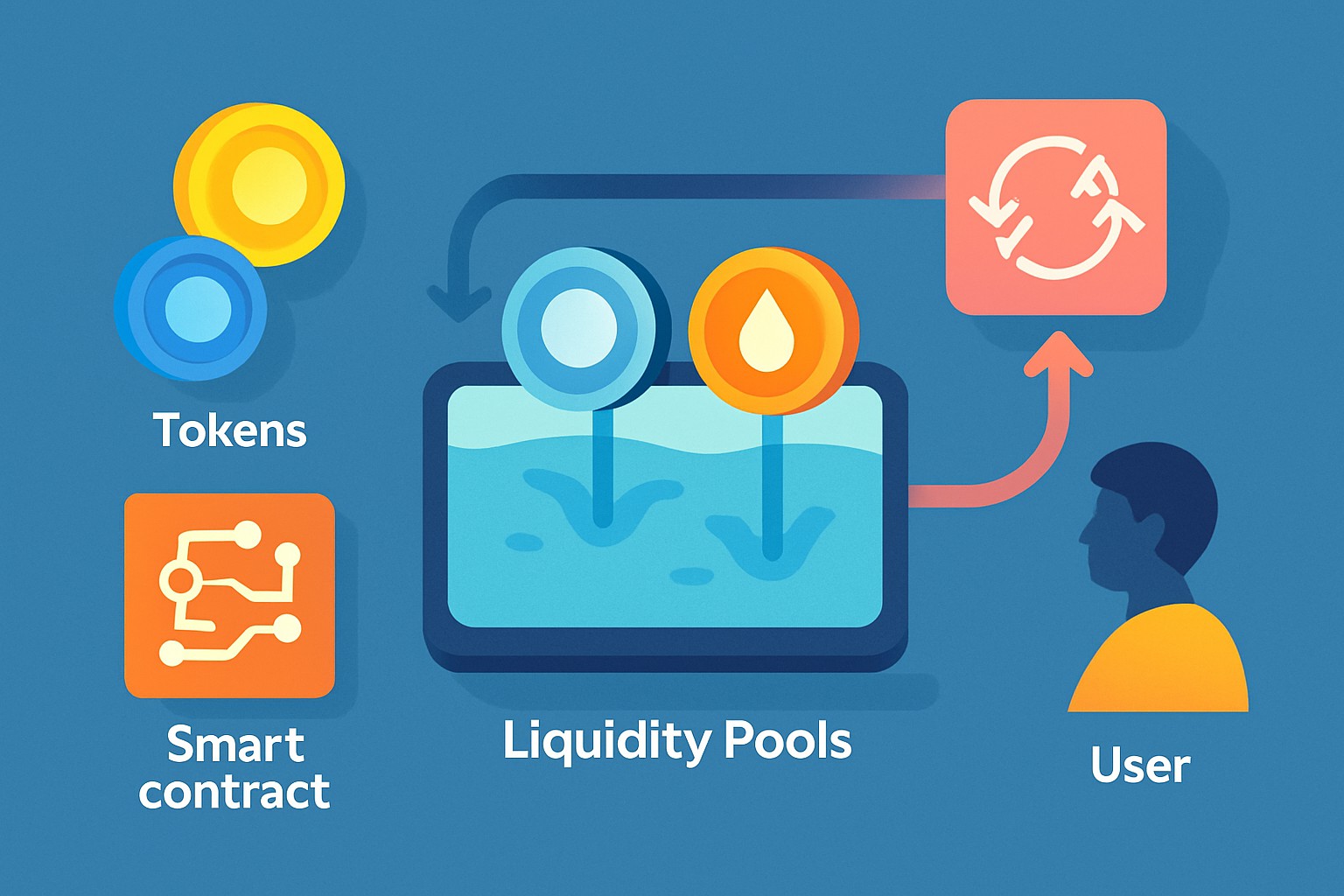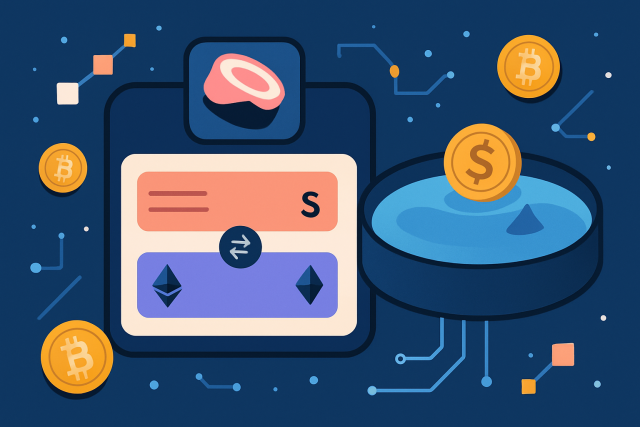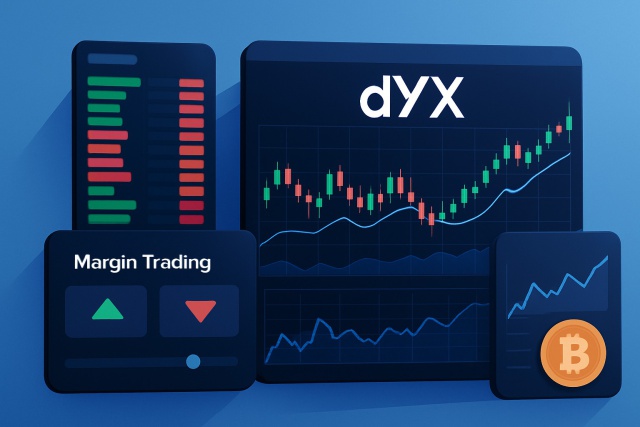Liquidity Pool Basics for DeFi Beginners


Liquidity pools are the unsung heroes of decentralized finance (DeFi) that quietly make trades happen without traditional middlemen. They might look daunting but are just smart contracts holding tokens to keep liquidity flowing on decentralized exchanges.
So, what exactly is a Liquidity Pool anyway?
A liquidity pool is a stash of tokens locked in a smart contract that powers decentralized trading by replacing traditional order books with an automated setup. Instead of waiting for buyers and sellers to place orders, liquidity pools keep a steady flow of tokens on hand so anyone can trade directly with the pool anytime.
Liquidity pools are kind of like a community cash box where everyone chips in to build up a common fund that anyone can dip into on the spot.
Understanding How Liquidity Pools Operate in DeFi A Closer Look Beneath the Surface
Automated Market Makers or AMMs are the beating heart of liquidity pools. They use clever mathematical formulas to figure out asset prices within the pool. These pools hold pairs of tokens—for example ETH and USDT—that let users swap back and forth with ease. Liquidity providers chip in equal amounts of these tokens to keep the pool well-stocked and ready for action.
A bit like putting your chips on the table in a game everyone’s playing.
The pool runs on automated algorithms that set prices and keep the market lively.
Traders can swap tokens directly with the pool, skipping the hassle of waiting for someone to take the other side of the deal.
Liquidity providers get a cut of the trading fees and sometimes extra rewards for keeping the show on the road.

What Makes Liquidity Pools the Unsung Heroes of Decentralized Exchanges?
Liquidity pools are the unsung heroes behind decentralized exchanges because they enable instant token swaps without relying on old-school centralized order books. They cut out the middlemen and ramp up transaction speed. They are vital for nailing down fair prices that reflect real supply and demand.
- Liquidity pools keep trades lightning-fast by always having something ready to buy or sell so you rarely have to wait around.
- They toss out centralized order books and middlemen, which is a big win for keeping everything decentralized.
- Pools usually help reduce trading slippage meaning users often end up with sweeter deals than they might expect.
- They tempt users to add liquidity by dishing out fees and rewards. This helps the whole ecosystem stay healthy and humming along.
- Thanks to smart contracts everything is out in the open—anyone can peek at what is in the pool and track transactions with no smoke and mirrors here.
Who Supplies Liquidity and What’s in It for Them?
Liquidity providers are the individuals who chip in token pairs to liquidity pools and basically step up as market makers. They lock their tokens away in smart contracts which keeps the pool liquid and lets trading run smoothly.
Along with fees, plenty of DeFi platforms throw in yield farming rewards or governance tokens as little cherries on top for LPs. These bonuses can seriously boost returns, though they do vary quite a bit depending on the pool and platform you’re dealing with.
Liquidity providers are the unsung heroes acting as market makers in decentralized finance, keeping trades flowing without a hitch while earning their fair share as a thank you for the risks they shoulder and the capital they put on the line.
Typical Risks Linked to Liquidity Pools (And What to Watch Out For)
Liquidity pools offer plenty of perks yet they definitely come with their fair share of risks. One major headache is impermanent loss, something that kicks in when the prices of tokens start doing their own dance relative to each other. If that wasn’t enough, pesky bugs or sneaky hacks in smart contracts can cause funds to vanish into thin air.
- Impermanent loss happens when the value of your invested tokens changes, which can lower your returns compared to simply holding those tokens on their own.
- Smart contracts are not always perfect and may have vulnerabilities that skilled hackers can exploit to quickly drain liquidity pools.
- Rug pulls remain a major risk. This occurs when developers abandon the project or suddenly withdraw all liquidity, especially on higher-risk platforms.
- Sudden changes in token pair prices can lead to unexpected losses.
- The regulatory landscape around DeFi is uncertain. Unclear rules can complicate how liquidity pools operate and the legal requirements involved.
Mitigating risks usually comes down to choosing reputable protocols that have passed solid security audits and sticking with well-known token pairs you can trust. You should also spread your liquidity across a handful of different pools. On top of that keeping an eye on platform updates and market trends helps LPs manage potential losses more smoothly.
A Beginner's Guide to Joining a Liquidity Pool Step-by-Step (No Sweat!)
Jumping into a liquidity pool is usually straightforward, especially with popular decentralized exchanges like Uniswap or SushiSwap leading the way. For those just starting out, you’ll need a Web3 wallet and the token pairs you want to supply. Remember to keep both sides balanced in value. That’s the trick. Once your wallet is hooked up to the platform, you can toss your tokens into the pool and start raking in fees almost immediately.
Choose a decentralized exchange with liquidity pools such as Uniswap or SushiSwap, which are the usual options.
Connect your Web3 wallet like MetaMask or Trust Wallet, whichever you prefer.
Look for a liquidity pool pair that matches the tokens you have. It’s similar to pairing wine with cheese, but for crypto.
Add both tokens to the pool in equal value to keep things balanced.
Confirm the transaction and monitor your liquidity position through the platform's interface to avoid any unexpected surprises.
You can easily keep an eye on your earnings through the platform dashboard and cash out your tokens and fees whenever the mood strikes.
Well-Known Liquidity Pools and Platforms That Are Definitely Worth Checking Out
| Platform Name | Supported Tokens | Fee Structure | Incentive Programs | Beginner Friendliness |
|---|---|---|---|---|
| Uniswap | Tokens based on Ethereum | A straightforward 0.3% fee on every trade | No official programs, but you’ll find some farms here and there | A breeze for those just starting out |
| SushiSwap | Tokens across multiple chains | Charges a 0.3% fee per trade | Sweet rewards paid out in SUSHI tokens and some enticing yield farming | Welcoming and approachable for newbies |
| Balancer | Pools featuring multiple tokens | Fees can vary quite a bit, topping out at 10% | Handoff some BAL tokens as rewards | A bit of a challenge because of its complexity, but worth the effort |
| Curve Finance | Focuses on stablecoins and wrapped tokens | Fees fluctuate between 0.04% and 0.4% per trade | Got CRV token incentives to entice users | Good for beginners moving toward intermediate skills |
| PancakeSwap | Tokens running on Binance Smart Chain | A wallet-friendly 0.25% fee on every trade | Earn tasty CAKE tokens as rewards | Super friendly to first-timers and beyond |
Each platform boasts its own unique features and rewards so choosing one usually boils down to the tokens you’re holding and the kind of perks you want. It also depends on how comfortable you feel navigating the platform’s complexity.
What Individuals Commonly Miss About Liquidity Pools
Liquidity pools tend to get tangled up in misconceptions that can easily throw newcomers off balance. Some individuals lump them together with staking. Others assume liquidity providers are sailing risk-free. A few expect sky-high rewards as a given.
- Liquidity pools aren’t quite the same as staking. LPs provide paired tokens to keep trading flowing smoothly, while staking usually means locking your tokens away to help secure the network.
- Jumping into liquidity provision comes with risks like impermanent loss, so it’s definitely not all sunshine and rainbows.
- Not every liquidity pool offers sky-high rewards. Your returns often depend on how much trading activity there is and what incentives are available.
- Swapping tokens on DEXs can sometimes cost more than you expect because of those pesky gas or transaction fees.
- The smart contracts powering these pools can have quirks and vulnerabilities. No matter how many audits they’ve gone through, they aren’t completely bulletproof.
Looking Ahead at the Future of Liquidity Pools in DeFi and What’s Next on the Horizon
Liquidity pools have been steadily evolving, especially with innovations like concentrated liquidity that allow LPs to squeeze more efficiency out of their capital. Cross-chain liquidity pools act like bridges connecting assets across different blockchains and unlock new opportunities. Meanwhile, improvements in risk management and smart contract security are making these pools safer and more appealing for those involved.
Frequently Asked Questions
What’s the difference between a liquidity pool and staking?
Liquidity pools let you deposit paired tokens like ETH and USDT into a smart contract to keep trading running and earn fees with each swap. Staking usually means locking up a single token to support the blockchain and earn rewards. Both can bring passive income, but liquidity pools have quirks like impermanent loss.
How do I know if a liquidity pool is safe to join?
It’s best to stick with pools on well-audited platforms like Uniswap or SushiSwap and pick established token pairs. Do some homework: check for past security issues, see community opinions, and ensure the smart contracts aren’t a black box. Be wary of obscure pools with sky-high rewards because they often hide traps like rug pulls.
Can I lose money in a liquidity pool?
Absolutely. Impermanent loss can happen if token prices drift far from your initial deposit. Then there are smart contract bugs, wild price swings, or platform glitches. A good rule is to spread bets across pools and research token pairs to limit losses.
How much can I earn as a liquidity provider?
Your earnings depend mostly on trading volume, which sets the fees per swap, plus perks like yield farming rewards. Pools with more activity usually pay steadier returns but the numbers can change with the market. Don’t forget gas fees and impermanent loss when calculating net profits since they can have a big impact.
Do I need equal amounts of both tokens to join a pool?
Yes, most pools require tokens split roughly 50/50 by value, for example, $100 of ETH and $100 of USDT. The platform usually handles the math for you to keep the liquidity balanced for traders.
What’s the easiest way to start with liquidity pools?
Start on user-friendly platforms like Uniswap or PancakeSwap and pick well-known pairs such as ETH and USDC. Connect a Web3 wallet like MetaMask, add your tokens, and watch your earnings on the dashboard. My advice: dip your toes in before investing bigger sums.






